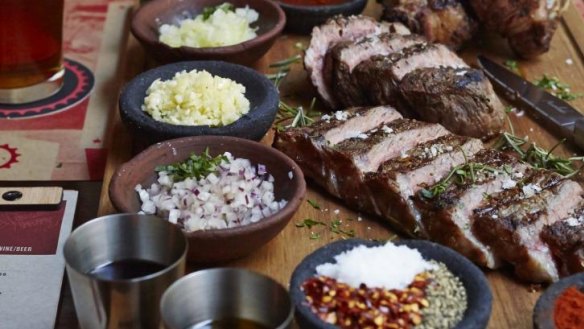The barbecue: three ways, three cultures

From the dips of the Dalmatian coast, to Argentinian 'Asados' and family gatherings in Syria, the barbecue has long been a part of food cultures across the globe.
Here are three ways different cultures approach the barbecue. These Sydney venues will be firing up their own grills this month as part of Cooking with Fire at Good Food Month.
An Argentinian barbecue
Barbecuing in Argentina is a whole-day affair.
"I remember having barbecues on farms with friends where we used to barbecue a whole cow," recalls Bridge St Garage executive chef and general manager, Oscar Gorosito.
"You start at 10am to get the fire ready, and the meat goes on at 10.30am when you have the first piece of charcoal coming out of the timber."
Come October 10, the Bridge St Garage kitchen will be no different. The full charcoal grill will be turned on early to begin charring meat for the first Flamin' Asados event.
"Argentinian barbecues feature whole pieces of meat – different cuts to those used in Australia – that are cooked on charcoal at a low temperature for a longer period of time," he explains.
"I create a salt rub (salt, water, pepper, dried chilli, paprika and oregano) that creates a nice crust... at the end, fresh sea salt to finish."
Diners will have the choice of traditional slow-cooked picanha, vacio or char-burnt roasted beef ribs, served with 'ensalada rusa' (potatoes, vegetables, boiled egg and mayonnaise) and chimichurri sauce.
"I'm going to go a bit more traditional and make the chimichurri sauce a little rougher, as we do in Argentina," says Gorosito.
"Contrary to how it is done in Australia, it is typically red – not green!"
The secret? Coriander, introduced in the 1990s, is replaced by chilli and paprika – a recipe that dates back to the early 1900s.
"Barbecuing has been a part of me since I was born. This is the way we have always done it."
Flamin' Asado Saturdays, Bridge St Garage, Ground Level, 17-19 Bridge Street, Sydney, October 10 and 17, 6-11pm, $45
MAKE YOUR OWN: Chimichurri and salmuera
A Syrian barbecue
"Middle Eastern barbecues are always big gatherings – you would normally invite all of your relatives, friends and neighbours. Generally, ours consist of 30 to 40 people," explains head chef of Almond Bar, Sharon Salloum.
"These barbecues happen rain, hail or shine. We've had to put up tarps mid-barbecue, or shift it from one spot to another – making sure we don't lose anything on the way!"
It is this family barbecue scene that sisters Sharon and Carol Salloum are bringing back to their Darlinghurst customers this year.
The Big Syrian Barbecue will be held on October 18 at Almond Bar, offering diners a mixed plate of traditional Middle Eastern dishes. Think barbecued lamb skewers and chicken drumettes ("that mum makes") served with sides and sauces - from fattoush salad and tabouli, to a smoky baba ganoush.
"Usually, we see baba ganoush as a dip that you have with bread. For us, it is something that we have as a side – we dip our meat into it," says Salloum.
Guests will be fed out the back of the venue's roller door, straight off the grill of three homemade barbecues.
"My dad makes our barbecues out of recycled pieces... The grill is made out of a fridge shelf, the base is metal scraps and it has lawnmower wheels!"
The event is set to showcase a Syrian barbecue in its authentic glory, where lamb – the national meat across the Middle East – is rubbed in an Arabic 'seven spice mix' and grilled over heat beads and charcoal.
The crowning glory? Middle Eastern bread basted in toum (garlic sauce) and grilled, to finish the meal.
The Big Syrian BBQ, Almond Bar; 379 Liverpool Street Darlinghurst, October 18, 12-2pm, $20 per plate.
MAKE YOUR OWN: Toum (Garlic Sauce)
A Croatian barbecue
"Growing up in a Croatian house, there was a lamb on a spit at every gathering," says Glass Brasserie's executive chef, Joe Pavlovich.
"And with that, Croatians keep it pretty simple," describing a typical Balkan barbecue that is all about showcasing proteins with fresh, hearty herbs, vinegars and a hefty slug of olive oil.
Akin to the 'grazing style' of traditional gatherings, Pavlovich will be cooking up a storm at Glass Brasserie on October 6 to provide a share plate barbecue experience. Bringing the Croatian community to the inner-city, he is hoping to celebrate traditional peasant food that is undiscovered in Sydney.
Entrees will feature Croatian salami, wood-fired sardines, 'cevapi' sausage and stuffed cabbage rolls. The crowning glory? A traditional lamb spit with accompanying oil-based salads.
"We traditionally use an open pit: everything is grilled over wood. The charcoal is used to spit your lamb or pig," explains Pavlovich.
But with its pristine setting on the Dalmatian coast, a Croatian barbecue is not all about the lamb.
"We use a lot of seafood – braised octopus, lobster and prawns – anything that you find in the Mediterranean," he says.
To finish off the meal, Pavlovich and his team will be offering diners a world-first dessert: Pag cheese, a delicacy sourced from the Adriatic island of Pag.
Cooking with a Fiery Croatian, Glass Brasserie, Level 2, 488 George Street Sydney, October 6, 6.30-9.20pm, $120 (including matched wines).
These three events are part of the Cooking with Fire series running throughout Good Food Month, presented by Citi, October 1-31, sydney.goodfoodmonth.com/cookingwithfire.